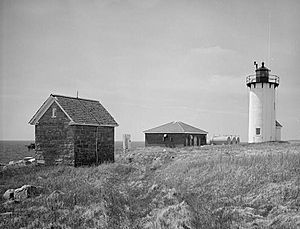Great Duck Island, Maine facts for kids
Great Duck Island is a small island located in the Gulf of Maine. It's about 1.5 miles (2.4 km) long and 0.5 miles (0.8 km) wide. This island is found about 11 miles (18 km) south of Frenchman Bay, not far from Acadia National Park. Great Duck Island, along with nearby Little Duck Island and 11 other islands, is part of the town of Frenchboro.
This special island is home to many animals. The Nature Conservancy says it has the biggest nesting group of black guillemot birds in Maine. Great Duck Island is also a busy place for ecological research. This means scientists study how living things interact with their environment. The College of the Atlantic runs the Alice Eno Biological Station here. Much of their work focuses on studying the nesting habits of a small seabird called the Leach's storm-petrel.
Contents
Island History
Great Duck Island was a place where people lived all year round for a long time. This started after 1837 when William Gilley bought the island. People lived there until 1986, when the Coast Guard left and the lighthouse began working automatically. For many years, the island was used to raise sheep. It also supported the lighthouse keepers and was a summer getaway for people who owned land there.
The Great Duck Island Light
The Great Duck Island Light was first built in 1890. The original lighthouse, the main keeper's house, the fog signal building, a storage building, and the boathouse from that year are all still standing today.
Pirate Treasure Story
In 1949, Bill and Ellen Bigenho bought most of the island. Their daughter, Ellen Spain, shared an exciting story. She said that in 1953, her parents used an old map from the 16th or 17th century. They dug on the island and found a pirate treasure! It was filled with gold and silver.
A Unique Community
In 1963, George Cloutier, a therapist from Boston, bought most of the island from the Bigenhos. In the 1970s, Mr. Cloutier built an airstrip on the island. He also started a special community there. This community included unique buildings like a geodesic dome and yurts. It was described as a very unusual experiment for an island. This community closed in 1979.
Protecting the Island
In 1985, The Nature Conservancy and the State of Maine worked together to buy most of the island. They now own it together. Later, in 1998, the College of the Atlantic took over the 12-acre (4.9 ha) light station area. In 2000, they renamed it the Alice Eno Biological Station. This helps protect the island's nature and supports important research.


